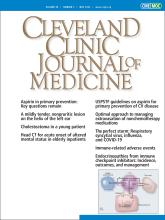To the Editor: I would like to add an important point to the useful review of the diagnosis and treatment of refractory hypertension by Yahr et al1 in the February issue, specifically the need to evaluate such patients for the possibility of pseudohypertension. It is possible, and in fact does occur, that patients may have both true hypertension and pseudohypertension.
In 1892, Osler described in some patients the persistent palpability of a pulseless radial artery after inflation of the sphygmomanometer cuff to above systolic pressure. Taguchi and Suwangool2 were the first to describe a patient with pseudohypertension, which they surmised was due to Mönkeberg medical sclerosis. Spence et al3 described pseudohypertension and the utility of the Osler maneuver in 1979, and this was confirmed by Messerli et al.4 In the study by Messerli et al, patients who were Osler-positive had falsely elevated blood pressure readings, with a difference of 10 to 54 mm Hg between the cuff pressure and the intra-arterial pressure. These patients had diminished arterial compliance, and the stiffer the artery, the more pronounced the degree of pseudohypertension.
The decreased compressibility or noncompressibility of the brachial artery is due to a combination of intimal calcification, as found in atherosclerosis, and degenerative medial calcifications known as Mönckeberg arteriosclerosis. Mönckeberg medial sclerosis is much more common in patients with diabetes and in patients with chronic kidney disease, as is pseudohypertension. Pseudohypertension is not simply a phenomenon of the discrepancy between blood pressure obtained noninvasively and that obtained intra-arterially. With aging, arteries gradually become less elastic and become larger and stiffer. In such arteries, the reflected wave returns faster and merges with the incident wave in systole. This increases left ventricular afterload and decreases coronary artery blood flow, which leads to left ventricular hypertrophy and increased central blood pressure with attendant untoward physiologic effects.5 Unfortunately, given that the gold standard for the diagnosis of pseudohypertension requires direct intra-arterial recordings, which is both invasive and impractical, this precludes its use in clinical practice.
Of note, another clue that a patient may have pseudohypertension is the presence of a prominent auscultatory gap (ie, phase 2 of the Korotkoff sounds) when measuring blood pressure.6 Obviously, this requires that a clinician take the blood pressure with a nonautomated sphygmomanometer. Pulse pressure is a surrogate marker for arterial stiffness, but it alone is inadequate to accurately determine arterial stiffness. Pulse-wave analysis more accurately provides physiologic data on central blood pressure and arterial stiffness but requires significant skill and, again, is impractical in daily practice.5 The pulse-wave velocity is generally accepted as the simplest noninvasive and reproducible method to assess arterial stiffness.7 Recently, a high reading of the brachial-ankle pulse-wave velocity was seen to have a positive predictive value for pseudohypertension in elderly patients.8 There are now available instruments that measure arterial stiffness indirectly by applanation tonometry and pulse-wave analysis. These arterial indices have been shown to have a better prognostic value than the mean arterial pressure or the brachial pulse pressure but have not been incorporated in clinical practice.5
I would recommend that any elderly patient diagnosed with hypertension have an Osler maneuver performed. A positive test would suggest the possibility of pseudohypertension. A significant auscultatory gap would reinforce that suspicion, as would the coexistence of diabetes and or chronic kidney disease. The clinician would then uptitrate the dose of the antihypertensive agent or agents in smaller increments than usual, but perhaps more frequently, until either the patient achieves their blood pressure goal or develops any symptoms of orthostatic hypotension. In the elderly, fatigue can also be a symptom or chronic orthostasis. At that point, the dose of antihypertensives would be scaled back to the last dose that was tolerated.
- Copyright © 2023 The Cleveland Clinic Foundation. All Rights Reserved.






